Eugène Ysaÿe
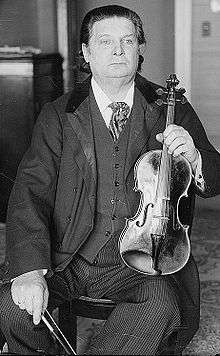
Eugène Ysaÿe (French: [øʒɛn iza.i]; 16 July 1858 – 12 May 1931) was a Belgian violinist, composer and conductor. He was regarded as "The King of the Violin", or, as Nathan Milstein put it, the "tsar".
Legend of the Ysaÿe violin
Eugène-Auguste Ysaÿe came from a background of "artisans", though a large part of his family played instruments. As violinist Arnold Steinhardt recounts, a legend was passed down through the Ysaÿe family about the first violin brought to the lineage:
It was told of a boy whom some woodcutters found in the forest and brought to the village. The boy grew up to be a blacksmith. Once, at a village festival, he astonished everyone by playing the viol beautifully. From then on the villagers took pleasure in dancing and singing to the strains of his viol. One day an illustrious stranger stopped in front of the smithy to have his horse shod. The count's servant saw the viol inside and told the young smith that he had heard a new Italian instrument played by some minstrels at the count's court. That instrument, called the violin, was much better than the viol – its tone was like the human voice and could express every feeling and passion. From that moment the young man no longer took pleasure in his viol. Day and night he was thinking of that wonderful new instrument that could express joy and sorrow and whose tones went straight to the human heart. Then he had a dream: he saw before him a young woman of indescribable beauty, not unlike his own love, Bienthline. She came to him and kissed his brow. The young man awoke and looked at the wall his broken and neglected viol used to hang on and could barely believe his eyes: there, instead of the viol, was a new instrument of beautiful proportions. He put it against his shoulder and drew the bow over the strings, producing sounds that were truly divine. The violin sang in a heartwarming tone: it rejoiced and wept for happiness – and so did the musician. Thus, goes the legend, came the first violin to the Ardennes and to the Ysaÿe family.
Early years
Born in Liège, Ysaÿe began violin lessons at age five with his father. He would later recognize his father's teaching as the foundation of everything he knew on his instrument, even though he went on to study with highly reputed masters. At seven he entered the Conservatoire at Liège studying with Désiré Heynberg 1865-1869, though soon afterwards he was asked to leave the conservatory because of lack of progress. This was because, in order to support his family, young Eugène had to play full-time in two local orchestras, one conducted by his father. Eugène went on playing in these ensembles, though he studied by himself and learned the repertoire of the violin. By the time he was twelve, he was playing so well that one day he was practicing in a cellar when the legendary Henri Vieuxtemps, passing in the street, was so impressed with the sound of his violin that he took an interest in the boy. He arranged for Ysaÿe to be re-admitted to the conservatory studying with Vieuxtemps's assistant, the noted Henryk Wieniawski. Ysaÿe would later also study with Vieuxtemps, and both "master and disciple", as Ysaÿe would call the roles of teacher and pupil, were very fond of each other. In his last years, Vieuxtemps asked Ysaÿe to come to the countryside just to play for him.
Studying with these teachers meant that he was part of the so-called Franco-Belgian school of violin playing, which dates back to the development of the modern violin bow by François Tourte. Qualities of this "École" included elegance, a full tone with a sense of drawing a "long" bow with no jerks, precise left hand techniques, and bowing using the whole forearm while keeping both the wrist and upper arm quiet (as opposed to Joseph Joachim's German school of wrist bowing and Leopold Auer's Russian concept of using the whole arm.)
Early career

After his graduation from the Royal Conservatory of Liège, Ysaÿe was the principal violin of the Benjamin Bilse beer-hall orchestra, which later developed into the Berlin Philharmonic. Many musicians of note and influence came regularly to hear this orchestra and Ysaÿe in particular, among whom figured Joseph Joachim, Franz Liszt, Clara Schumann, and Anton Rubinstein, who asked that Ysaÿe be released from his contract to accompany him on tour.
When Ysaÿe was twenty-seven years old, he was recommended as a soloist for one of the Concerts Colonne in Paris, which was the start of his great success as a concert artist. The next year, Ysaÿe received a professorship at the Brussels Conservatoire in his native Belgium. This began his career as a teacher, which was to remain one of his main occupations after leaving the Conservatoire in 1898 and into his last years. Among his more respected pupils are Josef Gingold, the viola virtuoso William Primrose, the violin virtuoso Nathan Milstein (who primarily studied with Pyotr Stolyarsky), Louis Persinger, Alberto Bachmann, Mathieu Crickboom, Jonny Heykens, Charles Houdret, Jascha Brodsky, Oscar Shumsky and Aldo Ferraresi. See: List of music students by teacher: T to Z#Eugène Ysaÿe.
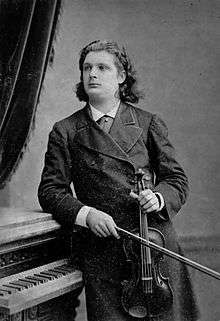
During his tenure as professor at the Conservatoire, Ysaÿe continued to tour an ever-broadening section of the world, including all of Europe, Russia, and the United States. Despite health concerns, particularly regarding the condition of his hands, Ysaÿe was at his best when performing, and many prominent composers dedicated major works to him, including Claude Debussy, Camille Saint-Saëns, César Franck, and Ernest Chausson. He arranged for violin and orchestra Saint-Saëns's Étude en forme de valse, which had originally been written for solo piano.
Mention should be made of Franck's Violin Sonata in A, written as a wedding present for Ysaÿe and his wife in 1886, which Ysaÿe played wherever he went for the rest of his life; and of Chausson's Poème, which was his response to a request for a concerto. Joseph Szigeti considered those two dedications particularly stand out in demonstrating the enormous respect in which Ysaÿe was held.
In 1886 he established the Ysaÿe Quartet, which premiered Debussy's String Quartet.
Teaching and composing
As his physical ailments grew more prohibitive, Ysaÿe turned more to teaching, conducting and an early love, composition. Among his most famous works are the six Sonatas for Solo Violin op. 27, the unaccompanied Sonata for Cello, op. 28, one Sonata for Two Violins, eight Poèmes for various instruments (one or two violins, violin and cello, string quartet) and orchestra (Poème élégiaque, Poème de l'Extase, Chant d'hiver, Poème nocturne, among others), pieces for string orchestra without basses (including Poème de l'Exil), two string trios, a quintet, and an opera, Peter the Miner, written near the end of his life in the Walloon language.
Ysaÿe had been offered the post of music director of the New York Philharmonic in 1898, but declined it due to his busy solo performance schedule. In 1918, he accepted the music director's position with the Cincinnati Symphony Orchestra, where he remained until 1922 and with which he made several recordings.
Finally, in 1931, suffering from the extreme ravages of diabetes that had necessitated the amputation of his left foot, Eugène Ysaÿe died in his house in Brussels and was interred in the Ixelles Cemetery in Brussels.
Performing career
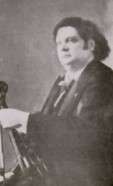
As a performer, Ysaÿe was compelling and highly original. Pablo Casals claimed never to have heard a violinist play in tune before Ysaÿe, and Carl Flesch called him "the most outstanding and individual violinist I have ever heard in my life."
Ysaÿe possessed a large and flexible tone, influenced by a considerable variety of vibrato — from no vibrato at all to very intense. He said, "Don't always vibrate, but always be vibrating". His modus operandi was, in his own words: "Nothing which wouldn't have for goal emotion, poetry, heart." The conductor Sir Henry Wood said, "The quality of tone was ravishingly beautiful.... He seemed to get more colour out of a violin than any of his contemporaries."[1]
Possibly the most distinctive feature of Ysaÿe's interpretations was his masterful rubato. Sir Henry Wood said, "Whenever he stole time from one note, he faithfully paid it back within four bars",[1] allowing his accompanist to maintain strict tempo under his free cantilena. Incidentally, this kind of rubato fits the description of Frédéric Chopin's rubato.
Although Ysaÿe was a great interpreter of late Romantic and early modern composers — Max Bruch, Camille Saint-Saëns, and César Franck, who said he was their greatest interpreter — he was admired for his Bach and Beethoven interpretations. His technique was brilliant and finely honed, and in this respect he is the first modern violinist, whose technique was without the shortcomings of some earlier artists.
An international violin competition in Brussels was created in his memory: in 1951, this became the violin section of the Queen Elisabeth Music Competition.
Personal life
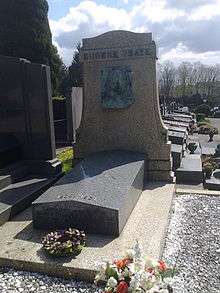
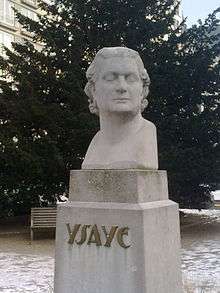
Ysaÿe was married twice. His first marriage, on 29 September 1886, was to Louise Bourdeau de Coutrai, with whom he had three sons and a daughter. César Franck presented his Violin Sonata in A to them as a gift on the morning of the wedding, and after a hurried rehearsal Ysaÿe performed the piece at the marriage celebration.[3] The sonata had its formal concert premiere in December 1886.
After Louise's death in 1924 he married a pupil of his, Jeanette Dincin (1902-1967), 44 years his junior. She was a violinist who in her teens had studied with prominent teachers such as Franz Kneisel, Leopold Auer, and Otakar Ševčík. Ysaÿe met her in 1922 while conductor of the Cincinnati Orchestra. She cared for him in his ailing years. Eugene's only request of her after he died was that she carry on her performances under his name.
His brother was pianist and composer Théo Ysaÿe (1865–1918), and his great-grandson is Marc Ysaÿe, founder-controller of radio Classic 21 and drummer of rock band Machiavel. Eugène Ysaÿe was also close friends with Queen Elisabeth of Belgium, whom he taught violin despite her lack of talent. His widow took over the royal teaching herself after his death, and the queen began the competition in his honor. His granddaughter, Nadine Syaye Mosbaugh, was a noted concert pianist who toured Europe with Jose Iturbi before settling down in Canada. She also hosted and performed on a classical radio program on CKAR Radio in Huntsville, Ontario. Ysaye's great-grandson, Franc Mosbaugh, is a Canadian musician/singer and award-winning commercial jingle composer.
Ysaÿe was also a friend of Claude Debussy and would sometimes correspond with him by letter.[4] The two had great respect for each other and Ysaÿe was a significant supporter of the younger composer's early career. Debussy dedicated his only string quartet to the violinist, who studied the score with great care.[5] The quartet received its premiere on 29 December 1893 by the Ysaÿe Quartet at the Société Nationale in Paris, to mixed reviews. The virtuoso and the composer also corresponded during the writing of Debussy's Nocturnes.
The Eugène Ysaÿe Collection
The Eugène Ysaÿe Collection, housed in the Music Division of the Royal Library of Belgium, combines four decades of purchases with a donation made by the Ysaÿe family in 2007. An essential source for the study of musician’s life and works, it includes some 700 letters and autograph scores, over 1,000 printed scores and books, abundant collection of photographs, four films, and about fifty 78 RPM and 33 RPM recordings.[6] A second collection of beautiful handwritten and printed scores is conserved in New York at the Juilliard School.[7]
Honours
- 1919 : Commander of the Order of Leopold. [8]
List of compositions
Works for solo violin
- 6 Sonatas for solo violin, Op. 27 (each dedicated to a different famous violinist and written in their corresponding styles)
- Sonata No. 1 ("Joseph Szigeti")
- Sonata No. 2 ("Jacques Thibaud")
- Sonata No. 3 ("Georges Enescu")
- Sonata No. 4 ("Fritz Kreisler")
- Sonata No. 5 ("Mathieu Crickboom")
- Sonata No. 6 ("Manuel Quiroga")
- 10 Preludes (Exercises for violin), Op. 35
- Étude posthume
- Cadenza for Beethoven, Violin Concerto Op.61, 1st mov. (1888–89)
- Cadenza for Tchaikovsky, Violin Concerto Op.35, 1st mov.
- Cadenza for Brahms, Violin Concerto Op.77, 1st mov.
Works for violin and piano
- 2 Mazurkas de Salon, Op.10 (1884) [No.1 'Dans le lointain'. Tempo di Mazurka; No.2 'Mazurka'. Moderato]
- Lointain passé, Mazurka No.3 in B minor, Op.11 (1893)
- Rêve d'enfant, in A flat major, for violin and piano (or orchestra) Op.14
- "Paganini Variations", on 24th Caprice (published 1960)
- "Caprice after the Study in the form of a Waltz, Op. 52/6" (composed by Camille Saint-Saëns, arranged by Ysaÿe)
- Deux célèbres Arias (composed by J.S. Bach and G.F. Handel, arranged by Ysaÿe)
- Waltz in E minor Op.posth. [KKIVa/15] (composed by Frédéric Chopin, arranged by Ysaÿe)
- Ballade No.1 in G minor, Op. 23 (composed by Frédéric Chopin, arranged by Ysaÿe)
- Légende norvégienne.[9]
Chamber works
- Sonata for solo cello, in C minor, Op.28 (1924) [1. Grave; 2. Intermezzo; 3. In modo di Recitativo; 4. Finale. Con brio]
- Piano Trio No.1, Op.33
- Sonata for two violins, in A minor, Op. posth. (1915) [1. Poco lento, maestoso - Allegro fermo; 2. Allegretto poco lento; 3. Finale. Allegro vivo e con fuoco)
- String Trio "Le Chimay", Op. posth. (1915) [Molto lento - Allegro non troppo - Lento ben sostenuto - Allegro non troppo - Allegro poco presto]
- String Quintet, in B minor, Op.15, for 2 violins, 2 violas and cello "à mon frère Théophile" (1894) [Grave et lent - Allegro]
- String Quartet
- "Paganini Variations" for String Quartet
- Piano Trio No.2 "2ème Trio Concertant"
Orchestral works
- Brabançonne in D major, for orchestra (1918)
- Exil, for string orchestra of only violins and violas, Op.25 (1917)
Concertante works
- Saltarelle carnavalesque, in A minor, for violin and orchestra (or piano) Op.11
- Poème élégiaque (Poème No.1) in D minor, for violin and piano Op.12 (1892/3) [orchestrated by Jacques Ysaye]
- Au rouet (Poème No.2), for violin and orchestra, Op.13
- Chant d'hiver (Poème No.3), in B minor, for violin and orchestra (or piano), Op.15 (1902) [same music of String Quintet]
- Méditation, for cello and orchestra, Op.16
- Berceuse, in F minor, for violin and orchestra, Op.20
- Extase (Poème No.4), for violin and orchestra, Op.21 (dedicated to Mischa Elman)
- Sérénade, for cello and orchestra, Op.22
- Les neiges d'antan (Poème No.5), for violin and orchestra, Op.23 (1911)
- Divertimento, for violin and orchestra (or piano) Op.24 (1921) [1. Molto moderato; 2. Allegro non troppo vivo]
- Amitié (Poème No.6), for 2 violins and orchestra, Op.26
- Poème nocturne (Poème No.7), for violin, cello and orchestra, Op.29
- Harmonies du soir, for string quartet and orchestra, Op.31
- Fantasia, for violin and orchestra, Op.32
- Violin concertos (some still unpublished):
- No.8 (orchestrated by Jacques Ysaye) [I. Grave e lento poco mesto; II. Andante non troppo; III. (with no tempo indication)]
Operas
- Piére li houyeû (Pierre le mineur) 1931 (Original in Walloon language, perhaps the only opera composed for a libretto in that language)
- The première of Piére li houyeû (the composer's only opera) took place at the Opéra de Liège on 4 March 1931, during a long evening dedicated to the composer's works, in the presence of Queen Elisabeth of Belgium who had been his pupil. Ysaÿe, who was very ill with diabetes, listened to the performance from his hospital room. The Queen, having been informed of the seriousness of Ysaÿe's condition, had organised the radio broadcasting of the work and Ysaÿe addressed the audience from his room. After this single performance, the work was performed in Brussels on 25 April. Ysaÿe, having been taken on a stretcher to box in the theater, was able to view the performance. On 12 May he died.
- The critics were appreciative but the opera did not find a place in the standard repertoire. It was performed again by Liège Opéra Royal de Wallonie on 25 November 2006. This performance was recorded and is published by the non-profit association "Musique en Wallonie" under the reference MEW 0884 - 0885 in a two CD set accompanied by a book containing the Walloon text and its French, Dutch and English translations, and introductory texts in French, Dutch, German and English. The story is based on an incident that occurred in 1877 during a miners' strike in the Liège region.[10] During clashes with the police, some shots were fired. The wife of a foreman rushed forward to seize a grenade which had been placed in the offices by a striker, but the grenade exploded and she was killed.
- L’avièrge di pièr (La vierge de pierre) - not completed, not performed
Selected discography
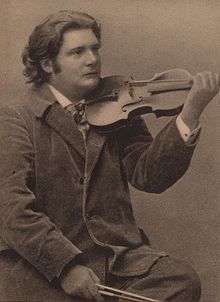
[Released on CD, Sony Classical MHK 62337, 1996]
Camille de Creus,[11] piano accompaniment
- R. Wagner: Prize Song from Die Meistersinger Von Nürnberg, recorded 1 Feb.1912
- E. Chabrier: Pièce pittoresque No.10 from Scherzo-Valse, recorded 20 Dec.1912
- R. Schumann: Abendlied, Op.85, No.12 by Schumann, recorded 24 Dec.1912
- H. Wieniawski: Obertass, Mazurka Op.19, No.1 in G major, recorded 26 Dec.1912
- H. Wieniawski: Dudziarz, Mazurka Op.19, No.2 in D major, recorded 26 Dec.1912
- G. Fauré: Berceuse Op.16, recorded 27 Dec.1912
- F. Mendelssohn: Concerto for Violin and Orchestra in E minor Op.64 (III: Allegro molto vivace), recorded 27 Dec.1912
- H. Vieuxtemps: Rondino Op.32, No.2, recorded 30 Dec.1912
- J. Brahms: Hungarian Dance No.5, in F-sharp minor (arr. Joachim), recorded 30 Dec.1912
- F. Kreisler: Caprice Viennois, Op.2, recorded 30 Dec.1912
- R. Wagner: Albumblatt in C major, recorded 30 Dec.1912
- E. Ysaÿe: Lointain passé, Mazurka No.3 in B minor Op.11, recorded 1 Feb.1913
- E. Ysaÿe: Rêve d'Enfant Op.14, recorded 1 Feb.1913
- A. Dvořák: Humoresque in G-flat major Op.101, No.7 (arr. Kreisler), recorded 9 Mar.1914
- F. Schubert: Ave Maria D.839, recorded 9 Mar.1914
- E. Chabrier: Marche Joyeuse, recorded 30 Nov.1919
Conducting the Cincinnati Symphony Orchestra, recorded 28 Nov 1919
- L. Delibes: Intermezzo from 'Naila' (Pas Des Fleurs, Grande Valse)
- Aimé Maillart: Overture to Les Dragons De Villars
- J. Massenet: Navarraise from 'Le Cid', by Massenet
- Eduard Lassen: Festival Overture
- E. Chabrier: Marche Joyeuse
- N. Rimsky-Korsakov: Scheherazade
- J. Offenbach: Orpheus in Hades
Notes
- 1 2 Sir Henry Wood, My Life of Music (Victor Gollancz 1938), pp171, 173.
- ↑ the text on the front side of the tomb stone reads: Monument érigé par le Comité National Belge de la Société des Auteurs Compositeurs et Editeurs de Musique. Which translates into: Monument erected by the Belgian National Committee of the Society of authors, composers and music publishers.
- ↑ "Classical Net - Composers - Ysaÿe". Classical Net.
- ↑ Weintraub, Stanley. 2001. Whistler: a biography (New York: Da Capo Press). ISBN 978-0-306-80971-2. p, 351
- ↑ Seroff, Victor. Debussy; Musician of France. New York: Putnam, 1956, 117
- ↑ Royal Library of Belgium, Fonds Eugène Ysaÿe
- ↑ Juilliard School, Eugène Ysaÿe Collection
- ↑ RD of 14.11.1919
- ↑ This work, written by Ysaÿe during a tour of Norway in the Spring of 1882, was discovered in 2013 by the Music Division of the Royal Library of Belgium. It was performed for the first time since the 19th century by the violinist Marc Bouchkov and the pianist Georgiy Dubko on October 17th, 2014 in the 2014-15 season of the Royal Library's concert series "Musical Treasures of the Royal Library of Belgium" http://www.kbr.be/actualites/concerts/concerts_fr.html
- ↑ "Ysaÿe: Pier Li Houyeu". prestoclassical.co.uk.
- ↑ De Creus (aka: Creus, Decreus), Camille Leo Ernest Jules (born: 23 Sep 1876, Paris, France - died: 26 Sep 1939, Fontainebleau, France), pianist and composer.
References
- Slonimsky, Nicolas (2001). Baker's Biographical Dictionary of Musicians (Centennial ed.). New York: Schirmer Books. ISBN 0-02-865525-7.
- Ginsburg, Dr. Lev (1980). Ysaÿe (English, Edited by Dr. H.R. Axelrod, translated from Russian by X. M. Danko ed.). Neptune City, New Jersey: Paganiniana Productions, Inc.
External links
| Wikimedia Commons has media related to Eugène Ysaÿe. |
- Eugène Ysaÿe at AllMusic
- Eugène Ysaÿe biography at the Classical Composers Database
- Eugène Ysaÿe at Find a Grave
- Free scores by Eugène Ysaÿe at the International Music Score Library Project
- Violinists of the Early Twentieth Century — Eugene Ysaÿe
